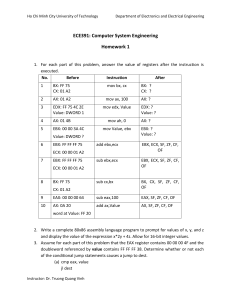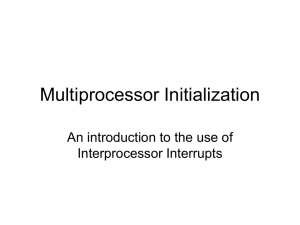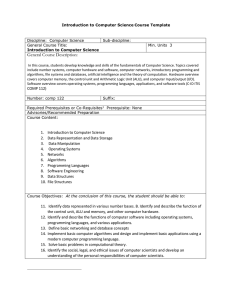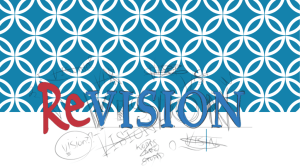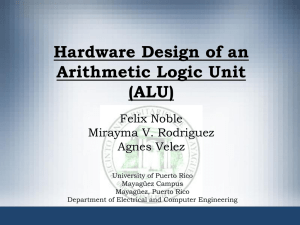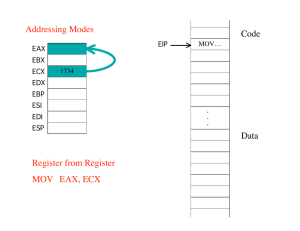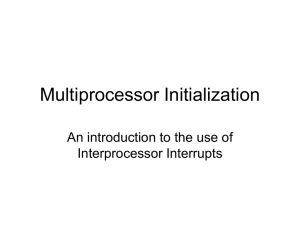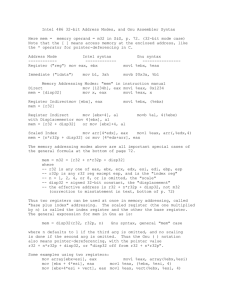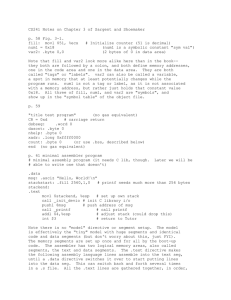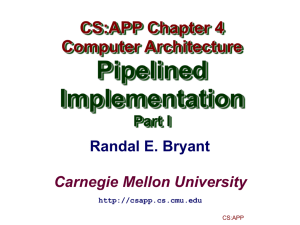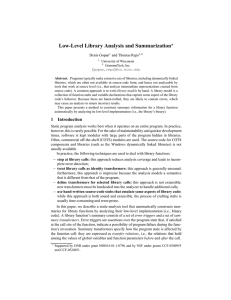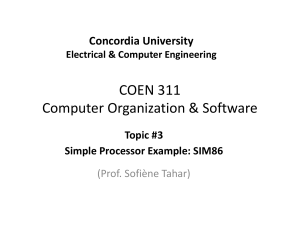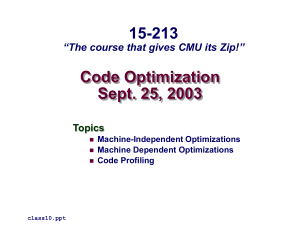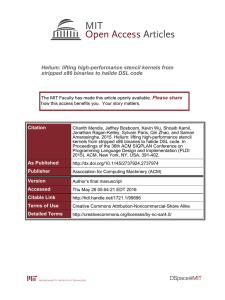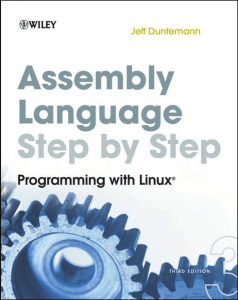CSE-111 Great Ideas in Computer Science Albert Y. C. Chen
advertisement
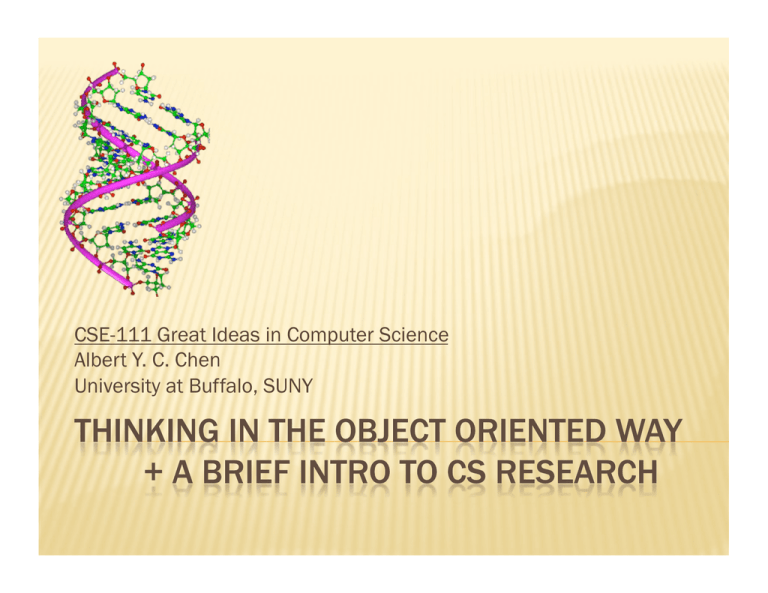
CSE-111 Great Ideas in Computer Science
Albert Y. C. Chen
University at Buffalo, SUNY
!!
Finally, putting everything all together. Also, we’ll learn
how complicated things are simplified by thinking in
the object oriented way.
From logic gates to making CPUs!
"! From machine language to Karel-the-robot to 3D dragon
drawing using the concepts of OOP!!
"!
!!
A gentle introduction to the fields of research in
computer science.
"!
What can we do with all the powerful tools we have
developed in the past few decades?
How are logic gates implemented on “semiconductors”?
!! e.g. NAND gate using CMOS:
!!
!!
Half Adder (1-bit)
Full Adder (1-bit)
!!
Ripple Carry Adder
Carry look-ahead Adder
!!
ALU: Basic building block for
computer’s CPU (Central
Processing Unit)
"!
Takes input A, B, then perform
the operation according to the
given instruction F.
#! Addition,
subtraction
#! Multiplication, division (optional)
#! Bitwise Logic op. (AND, OR, NOT)
#! Bit shifting operations
"!
E.g. (right) 2 bit ALU that does
XOR, AND, OR, addition.
!!
The “die” of Intel’s Core 2 Duo (Conroe) CPU
"!
With machines so complicated and powerful, how are we
going to send instructions (the control signal “F” in the ALU
example) to the ALU?
!!
Starting with the 2 bit ALU.
We can have 00, 01, 10, 11 four different kind of control
signals, i.e. we can integrate 4 different operations into this
ALU (e.g. F=00 XOR; F=01 AND; F=10 OR; F=11 addition).
"! Examples
"!
#! Suppose
we want to perform A+B, where A = 00 and B = 10, and
suppose the instructions sent to the ALU are 6 Boolean digits of the
order “2 bit command” “2 bit A” “2 bit B”.
#! We’ll look up the command for “+”, which is “11”, then write
“110010” in our program as the instruction for the ALU.
#! When the ALU receives 110010, it will decode it and know that you
want it to set F=11 (which is to perform addition”, and the inputs are
A = 00, B = 10
!!
Are these four instructions sufficiently enough?
"!
Not actually, we’ll also need instructions to:
#! Control
flow instructions such as “if”, “else”.
#! Data control instructions to move things around in the memory.
!!
Should all commands be implemented in hardware?
"!
CISC (Complex Instruction Set Computer):
#! Powerful
commands, yet takes longer for each command to be
executed.
"!
RISC (Reduced Instruction Set Computer):
#! Simpler
commands, each command runs faster, but may takes more
commands to do a job.
"!
For example, a ALU only capable of doing “addition” can
calculate “2x5” by doing “2+2+2+2+2”.
!!
Writing a program directly in CPU instructions:
01010010 11001011 10100101 000100100 10011010 ...
Ugh ... Can we write these in decimal or hexadecimal?
"! OK, here’s the 32-bit x86 machine code (1st generation
programming language) to calculate the nth Fibonacci
number (i.e. 0,1,1,2,3,5,8,13,21,34,55,89,...)
"!
8B542408 83FA0077 06B80000 0000C383 FA027706 B8010000 00C353BB
01000000 B9010000 008D0419 83FA0376 078BD98B C84AEBF1 5BC3
!!
!!
Instructions that we can finally remember (sort of...)
Still “Machine Dependent”, thus still “low level”.
"!
!!
i.e. code would need to be completely re-written whenever Intel or AMD
introduces a new CPU...
Fibonacci number calculator in MASM assembly language:
fib:
mov edx, [esp+8]
cmp edx, 0
ja @f
mov eax, 0
ret
@@:
cmp edx, 2
ja @f
mov eax, 1
ret
@@:
push ebx
mov ebx, 1
mov ecx, 1
@@:
lea eax, [ebx+ecx]
cmp edx, 3
jbe @f
mov ebx, ecx
mov ecx, eax
dec edx
jmp @b
@@:
pop ebx
ret
!!
Provides a higher level of abstraction from details of
the computer (e.g. CPU commands, registers, ...etc.)
"!
Our Karel-the-robot language is high level.
#! So
are Basic, C, C++, Java, Python, ... almost any programming
language you can think of.
#! The term “high” doesn’t mean it’s superior to low level languages, its
that it provides a higher level of abstraction.
"!
So, what’s the difference?
#! Instead
of sending “11010101” or “mov edx [esp+8]”, we use
commands that are very similar to plain English (if, else; while {...})
#! Instead of specifying which “CPU register” or “memory location”
we’re going to access, we use “Variables” to store data.
!!
Fibonacci Numbers: 0,1,1,2,3,5,8,13,21,34,55,89,...
"!
!!
The Nth number is the sum of the (n-1)th and (n-2)th number
Using Karel’s parental language “Pascal”:
program fibonacci
var
NumOfFibs, i, prevNumOne, prevNumTwo, currentNumber : integer;
begin
NumOfFibs := 10; i:=0; prevNumOne := 1; prevNumTwo := 0;
writeln(prevNumTwo); writeln(prevNumOne);
while i<NumOfFibs-2 do begin
currentNumber := prevNumOne + prevNumTwo;
writeln(currentNumber);
i := i +1;
prevNumTwo := prevNumOne;
prevNumOne := currentNumber;
end;
end;
!!
!!
Compilers do all the hard work of
translating programming languages to
machine-specific instructions.
When we write in Karel and hit the
button “compile”, our code is examined
by the compiler in the following order:
"!
"!
"!
!!
Lexicons (the vocabulary we used, e.g. “if”)
Syntax (e.g. missing “;”, “end;”)
Semantic...
A translator of this sort will be needed
for every two layers in the programming
language pyramid shown in the upper
right figure.
!!
Why OOP?
Hardware and software became increasingly complex.
"! To assure “quality” and “code re-usability”
"!
#! It’s
impossible for a 3D game developer nowadays to write codes for
each pixel he/she wants to display on the screen – It will not only be
slow, but also prone to error.
Spacewar! (1961)
Ultima1 (1980)
Doom (1993)
World of Warcraft (2004)
!!
Yet another way of thinking in/teaching OOP.
"!
Today, if we are “dragon behavior/motion specialists” and
hired by our favorite gaming company to develop the latest
game.
#! Wait...
I don’t know how to code in 3D yet!?
(don’t panic, be cool...)
#! Let’s ask the programmers to do us a favor:
give us a black box, we’ll input the (x,y,z)
location of the dragon’s major joints, and
the box will draw the dragon.
#! The programmers would go home and think:
I guess the dragon’s head, torso, tail, two
wings and four legs will move separately.
Maybe I’ll need 9 smaller not-so-black boxes
to implement the movements of these parts.
"!
(Continuing with the “dragon
coders” in the last slide)
Each smaller box will need at
least the following components:
a muscle object, and a skin
object. The smaller not-so-black
box will draw the head/tail
according to the muscle object
and skin object.
#! Suppose the “skin objects” are
composed of 10 different kinds
of scales, which we call it the
“scale object”. Skin is drawn
according to the scale objects
provided.
#! Finally, each scale is composed
of multiple “polygons” (basic
drawing unit of 3D objects)
#!
!!
What have we learned from the hardware and
software sides of the story?
"!
"!
!!
When things gets huge and complicated, we better break down the
problem nicely, work as a team, and each be in charge of developing a
reliable part (object).
When we fit the parts (objects) together (or using those developed by
our predecessors), we can create some really nice stuff.
What tools besides “the concept of OOP” can we rely
on to tackle other problems?
"!
Powerful hardware, a nice operating system, high-level programming
languages, and compilers that takes care of most low level interactions
with the hardware.
Instead of starting with a boring long list of research
topics, let’s ask ourselves, what do we want our
computers to do for us?
!! Basic problems that trouble us:
!!
"!
“Run faster you stupid computer!!! ”
#! If
you want to devote yourself to fixing this problem, please refer to:
Digital Logic, VLSI, Computer Architecture, High Speed Computing
(including distributed and parallel processing)
"!
“OS crashed!!! @#$%&*)#@% !!!”
#! Operating
"!
System, Embedded Systems
“Run/Compile you stupid Karel!!!”
#! Programming
Languages, Compilers
!!
Intermediate problems that trouble us:
"!
“Why is my (wireless) internet so slow?”
#! Network
Design and Analysis, Wireless and Sensor Networks,
Security, probably even some Information Theory and Coding, Graph
Theories, Operating Systems
"!
“My SPAM filter doesn’t work... Can I design a better one?”
#! Machine
"!
Learning
“I told my cell to call Monica, but it called mom”
#! Signal
Processing and Machine Learning,
better off with knowledge in Linear Algebra,
Numerical Analysis, Probability and Statistics.
!!
Advanced problems that might occasionally trouble us:
"!
“I want to study science, and help create a world without
cancer” (from RPCI’s commercials)
#! There’s
still a long way to go, but here’s what computer scientists
can help other disciplines of research analyze their data:
#! Bioinformatics (including gene analysis) , Cognitive Science,
Computational Chemistry, Computational Neuroscience,
Computational Physics.
!!
Advanced problems that might never trouble us:
"!
Problems such as the Traveling Salesman Problem (TSP):
#! Given
a number of cities and the costs of travelling from any city to
any other city, what is the least-cost round-trip route that visits each
city exactly once and then returns to the starting city?
#! Algorithms,
Analysis of Algorithms, Computational Complexity
Theory, Computability Theory, Graph Theory, ... etc.
!!
Problems that only trouble us in our daydreams:
"!
“Can’t my computer just do everything for me? (study, take
tests, drive the car, feed me...)”
#! Artificial
Intelligence, Computer Vision, Machine Learning, Pattern
Recognition, Robotics.
"!
How hard is it to teach a computer to
tell between leaves and grass, sky and
ocean, roads and buildings?
#! Very
very hard...
#! Even the most advanced systems could
only achieve around 75%-80% accuracy.
!!
Problems, problems, problems:
"!
Given an image, what color space should one use? Or
should one use infrared, ultraviolet sensors instead of
visible light?
RGB
HSV/HSB
YUV
RGB v.s. visible colors
"!
Take leaves for example, should we learn by their color?
texture? shape? size!!?
Since there is no “universal solution”, we usually take MANY
of the features into account.
"! How are we going to weigh/normalize different features?
How are we going to calculate the similarity between
features?
"! Pattern Recognition will shed some light.
"!
"!
Pattern Recognition will try to learn/discriminate the
distribution of different groups of objects.
LDA
K-means
SVM
#! These
are just the “easier to illustrate” ones.
#! Supervised v.s. unsupervised?
#! Over learning v.s. generality?
#! Parametric v.s. Non-parametric?
#! Generative Models v.s. Discriminative methods?
"!
This is just the beginning of all the struggles !

